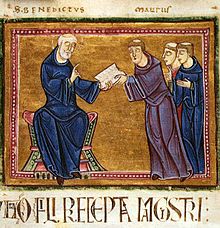The Legacy of St. Benedict:
Monasticism in the Western Church
Born
about 540 A.D., Benedict was sent to get a liberal education by his wealthy and
distinguished parents. However, once he encountered the dissolute life led by some
students, “in his desire to please God alone, he turned his back on further
studies, left home and inheritance and resolved to embrace the religious life.[1] Some authors have noted that, although
Benedictine spirituality is often associated with learning, its founder was
focused not on formal education, but on a simple life of work and prayer.
One of
the first miracles chronicled by Pope Gregory was an incident that involved
Benedict’s nurse, who had accompanied him in his search for a place to withdraw
from the sinfulness of the world. Having asked to borrow a tray for cleaning
wheat at the house where they were lodging, the nurse accidentally allowed he
tray to fall and break in two. When Benedict returned and saw her weeping, “he
prayed earnestly to God … (and) soon noticed that the two pieces were joined
together again.” [2]
Shortly
after this, Benedict left his nurse and proceeded to Subiaco, where he spent
three years in prayer and solitude. During that time the monk Romanus, who had
clothed Benedict in a simple habit, brought him food and drink. It is in this
period, too, that Benedict experienced perhaps the most famous of his
temptations, in which the devil tried him with lustful images. The young man responded
by throwing himself naked into a patch of nettles so that “the pain that was
burning his whole body had put out the fires of evil in his heart.”[3]
From that day forward, Benedict was free from this kind of temptation and began
to instruct others in the way to live for God.
Another
event in Benedict’s life shows how God intervened to guide him. He and his twin
sister, Scholastica, who had been consecrated to God from an early age, would
meet periodically to encourage one another and pray together. One time when
they had praised God all day and darkness was falling, Benedict, ever mindful
of his vow of stability, wished to return to his monastery. Scholastica
entreated him to stay the night, so they could continue talking and praying
together. When her brother refused, she prayed earnestly and the sky, which had
been clear, clouded over and a great storm arose, making it impossible for
Benedict and his brothers to leave. The siblings spent the night talking of the
joys of heaven and, when Benedict finally reached his monastery the next day,
he had a vision of Scholastica’s soul entering heaven. He then rejoiced at her
glorification, gave thanks to God and brought her body to be buried in a plot
near his monastery. [4]
An often-told story throws light on the virtue of Benedict and his direction of his brother monks. It seems a certain priest, Florentius, who lived in the neighborhood of Benedict’s monastery, observed that the saint had inspired many to a more fervent piety. Seized by envy and hatred for Benedict, Florentius sent him a loaf of bread he had poisoned, hoping to kill his rival. Benedict, however, knew what was in the bread and gave it to a raven to take away.
Foiled
in that attempt, Florentius then sent naked dancing girls to compromise the virtue
of the younger monks. Fearing that his monks would fall into temptation,
Benedict took them and left the monastery. As they journeyed away from their
home, God struck Florentius dead when the roof over him collapsed. One of
Benedict’s monks, Maurus, caught up with him and gave him the news, rejoicing
in Florentius’s demise. Benedict reprimanded Maurus severely and gave him a
penance for showing pleasure that another had died unrepentant of his sin.[5]
The fact that Gregory calls Benedict, “vir
Dei,” indicates in what high regard he was held even shortly after his
death.

Eventually
Benedict wrote his rule for all the foundations he had created and it has
remained the standard for much of monasticism up the present day. Modern
historians believe that the Rule of the Master, which is a much longer and more
detailed set of prescriptions for the pursuit of perfection, may have influenced
Benedict, but there are many differences in style and content between the two.
Benedict’s
rule is uncompromising in what is necessary for the pursuit of perfection, but
still gentle in its language. His description of the Abbot is that of a loving father,
who adjusts his methods of direction to the temperament of each monk. The Rule
covers many topics, but in no very discernible order. One part may talk about
the celebration of Lauds on feasts, while shortly thereafter the saint treats
of who shall sit at the Abbot’s table or how absent brethren are to be
received. Nevertheless, it covers most questions and details practices
necessary for a well-ordered community life.
[1]
Pope St. Gregory the Great, Life and
Miracles of St. Benedict (Book Two of the Dialogues) tr. By Odo J.
Zimmerman, O.S.B. Collegeville, Minnesota: The Liturgical Press,
[2]
Pope St. Gregory the Great, p.3.
[3]
Pope St. Gregory the Great, p. 8
[4]
Pope St. Gregory, pp. 69-70.
[5]
Pope St. Gregory, pp. 23-25.
No comments:
Post a Comment